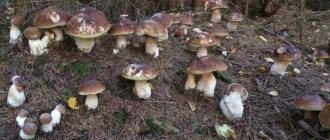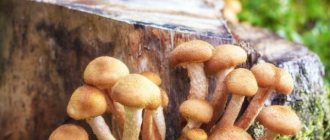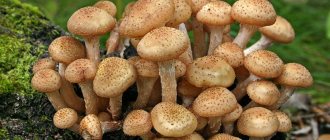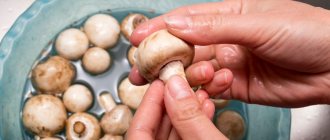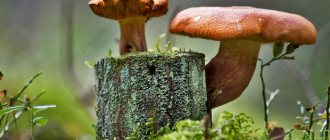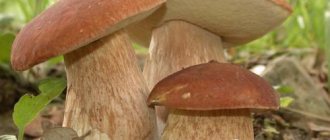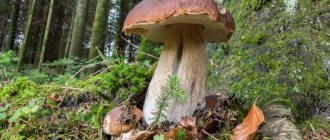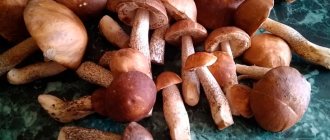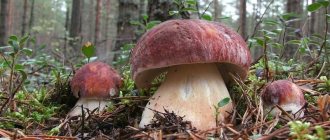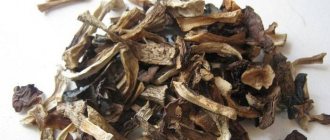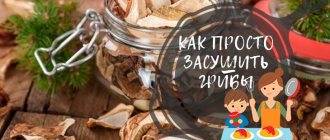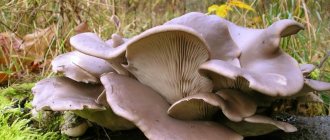Every experienced mushroom picker knows how to properly collect mushrooms, and for those who are just starting to learn the intricacies of “silent hunting”, it will be useful to know how to properly fill their basket with fragrant gifts from the forests.
You will learn the basic rules for collecting edible forest mushrooms, as well as medicinal chaga and veselka, from this article.
Tips for a novice mushroom picker on mushroom picking
Beginning mushroom pickers can be advised to collect only tubular varieties, among which there are no deadly mushrooms. The most common, highly nutritious and very popular tubular varieties among mushroom pickers include the fruiting bodies of white or boletus, boletus and boletus, as well as boletus.
Some types of tubular fruiting bodies are not collected by mushroom pickers due to their low nutritional value or unpleasant taste characteristics. Occurring conditionally poisonous species lose their toxicity during prolonged and repeated heat treatment. The mushroom broth obtained as a result of cooking is disposed of and not used for food purposes.
Learning to correctly distinguish between poisonous and edible varieties of agaric mushrooms is much more difficult. It is in the category of lamellar fruiting bodies that the most toxic and deadly species, represented by fly agaric and toadstool, belong. It is important to remember that it is strictly forbidden to collect old, rotten or damaged fruiting bodies by insects or worms, which contain an increased amount of toxic substances.
Mushrooms growing near busy roads, in urban areas, and near industrial enterprises are not edible. In this case, the mushroom pulp may contain significant amounts of radioactive elements, heavy metals or lead. Among other things, you need to remember that traditional means of testing, including silver objects, onions and garlic, as well as milk, do not allow one hundred percent accuracy to determine toxicity.
Storage rules
A novice mushroom picker, among other things, should remember that mushrooms cannot be stored fresh for a long time. Overstayed fruiting bodies can even cause poisoning.
“Prey” brought from the forest must be immediately soaked in water, cleaned and processed. Mushrooms can only be stored for a very short period of time. It is believed, for example, that honey mushrooms, milk mushrooms, chanterelles and most other mushrooms can be kept in the refrigerator at a temperature of 5 ° C for no longer than 3-5 days. At a temperature of 7-10 °C, mushrooms must be eaten no later than 12-17 hours.
Also, a forester I know does not recommend washing mushrooms before storing. It is better to keep milk mushrooms, boletus, chanterelles, etc. in the refrigerator in an enamel tray or glass container in the form in which they were brought from the forest. In any case, it is not recommended to store mushrooms in plastic. In such a container, fruiting bodies may lose their natural taste and aroma over time.
Found a violation? Report content
Mushroom picking time in Russia
The mushroom season in our country is a fickle concept and very much depends on soil and climatic conditions. March is the least mushroom month, but already in April and May the fruiting bodies of morels, May or St. George mushrooms, as well as the common boletus appear.
The onset of summer is marked by the appearance of porcini mushrooms, boletus, boletus, and boletus, and in August the third mushroom layer begins. At this time, fruiting bodies of several dozen edible varieties are formed. The peak of the mushroom season in our country occurs in September and the first ten days of October. It should be noted that the main natural factors, which are represented by humidity and temperature, have a special influence on the growth and period of active fruiting.
In Lipetsk
Within the city limits, inspecting plantings and forest areas is almost useless and undesirable due to the risk of collecting trophies that are harmful to health. Ecologically clean Whites grow in the forests of Dobrovka, as well as in the Karamashevsky district. Plekhanovsky district can also be considered a hot spot, although chanterelles predominate here.
When are mushrooms collected in Ukraine?
Soil and climatic conditions in Ukraine are very favorable for the growth and development of fruiting bodies of many types of mushrooms. More than two hundred species of edible mushrooms grow here, but only 10%, or about twenty of the most famous and popular varieties, are particularly popular among experienced connoisseurs of “silent hunting” and novice mushroom pickers.
The season of active fruiting of mushrooms starts in the first month of summer. It is during this period that a large number of russula and fly mushrooms appear. From the first ten days of July you can harvest boletus and boletus, moss and boletus mushrooms, chanterelles and porcini mushrooms. A temporary reference point can be the ripening of wild raspberries, blackberries and blueberries. However, the most productive months for mushrooms are August and September. And already in October there is an active collection of honey mushrooms, valuevs and milk mushrooms.
Honey mushroom is the largest living organism on the planet
0
Source:
In 1998, a team from the US Forest Service began investigating the causes of the decline of large trees in the Malheur National Forest in eastern Oregon. They identified affected areas in aerial photographs and collected root samples from 112 dead and dying trees, mostly spruce. Tests showed that all but four trees were infested with the honey fungus Armillaria solidipes (formerly known as Armillaria ostoyae). The most widely located were 3.8 km apart. The team estimated that the mushroom covered an area of 9.6 km² and was between 1,900 and 8,650 years old.
What you need to know about picking mushrooms in the forest
Compliance with the rules for collecting mushrooms allows you not only to minimize the risk of poisoning, but also helps to preserve the reproduction of mycelium in subsequent years.
Mushrooms are collected early in the morning , even before their above-ground part is warmed up by the sun's rays. Such fruiting bodies last as long as possible. You cannot collect overgrown or old mushrooms. It is more correct to place fruiting bodies in a wicker basket with their caps facing down. This method of transportation allows them to be preserved best. It is necessary to collect only well-known varieties.
In summers that are too rainy, the fruiting bodies become heavily saturated with water, causing the pulp to become watery, loose and decomposing. Such mushroom pulp becomes unsuitable for consumption. Fruit bodies collected and brought home are immediately cleaned of adhering particles of soil, leaves and needles, as well as grass and other plant debris. It is also mandatory to remove all parts that are affected by insect larvae. Parts of the legs that are heavily soiled are cut off.
Only young mushrooms with fairly dense flesh are used for food. It is advisable to immerse the peeled mushrooms in cold salted water for about an hour, after which they are processed and subjected to reliable heat treatment as soon as possible. The basic rule that must be followed when collecting fruiting bodies remains the same - you can only collect familiar and benign species that can be safely used for food purposes.
Cut or twist?
Most mushroom pickers believe that it is best to cut mushrooms in the forest with a knife, leaving only a small piece of the stem. The advantage of this technique is that when using it it is impossible to damage the mycelium. Consequently, in the future the mycelium will continue to produce new fruiting bodies. By pulling mushrooms out of the ground and damaging the mycelium, the mushroom picker risks “spoiling” his own mushroom place.
Stability: Russians named it the most important factor for living
A stray dog showed up at a bachelor party and found a home for herself and 7 puppies
“Gaining weight is not a problem”: what Boris Dergachev is ready to do for work
Some experienced mushroom pickers also believe that the stumps remaining after cutting the mushroom, rotting, can spoil the mycelium itself. Therefore, they advise beginners to twist the fruiting bodies without using a knife. Of course, you can use this method to collect mushrooms. However, in this case, you need to twist the fruiting bodies out of the ground as carefully as possible. Of course, you shouldn’t pull out the threads of mycelium on the stem.
How to pick mushrooms (video)
Looking for mushroom places in the forest
Edible mushrooms with high nutritional value can be found in a variety of places, so going on a “quiet hunt” doesn’t have to be in the forest. The fruiting bodies of edible species actively grow and develop on the edges, as well as clearings, in copses and low herbs. The mycelium is capable of growing well, so you can find fruiting bodies in places where high yields were noted in past years.
Each variety is characterized by the ability to form mycorrhiza with certain plant species. For example, in young and mature pine plantings, porcini mushrooms bear fruit very abundantly, as well as fly mushrooms, russulas of several varieties, and even boletus mushrooms, traditional for our country. Spruce forests most often grow saffron milk caps and chanterelles, forest champignons and russula. And in fairly humid, floodplain forests with not very good lighting, edible honey mushrooms and morels form fruiting bodies. Common champignon and meadow honey fungus bear fruit among meadow grasses and pastures.
Which wild mushrooms should not be put in the basket?
Only experienced mushroom pickers can independently distinguish edible species from inedible or poisonous varieties. It must be remembered that not only the most famous fly agarics and toadstools can be poisonous, but also the so-called double mushrooms or false mushrooms, which in appearance resemble such valuable varieties as porcini mushrooms, honey mushrooms, boletus and chanterelles. The following types of mushrooms are among the most dangerous to human life and health:
- pale grebe , found from the first ten days of August until the end of September;
- false chanterelle or orange talker , found from the first ten days of July to mid-October;
- false honey fungus , found from the first days of summer until mid-October;
- fly agaric toadstool , found from the middle of the last summer month to mid-September;
- satanic mushroom , found from the first days of summer until the onset of a steady autumn cold snap;
- Russula is pungent and pungent , found from mid-summer to mid-autumn;
- gray-pink laticifer , found from the last ten days of summer until the onset of steady autumn cooling;
- red trellis , growing in forests from the last ten days of spring until the onset of autumn;
- beautiful gymnopilus , growing from the last ten days of the first summer month until mid-September;
- Valui false, growing from the first ten days of the last summer month until the end of September.
Among other things, you should not collect and use for food purposes overgrown or worm-eaten fruiting bodies, which can cause poisoning and problems with the gastrointestinal tract. Mushroom pulp that is excessively saturated with water may indicate severe overgrowth or damage to the fruiting bodies. In the process of such natural decay, the formation of substances harmful to human health can occur, including the poison neurin, which makes mushrooms poisonous.
Veselka vulgaris - the fastest growing mushroom
0
Source:
Soon after temperatures begin to drop, and especially after wet weather, you may find a little surprise in your yard: phallic-looking mushrooms that appear seemingly out of nowhere. They are called Phallus Impudicus or Common Vesel. The 16th-century botanist John Gerard called them “prickly mushrooms” or “Virilis penis fungus.” The reason is obvious: they look like you know what. Some cultures consider the mushrooms to be aphrodisiacs and even feed them to bulls before they mate. In fact, Phallus Impudicus is nothing more than a type of stinking fungus that appears in cool and damp weather, mainly in autumn and winter. They start with a white “egg” that is partially visible above the ground, with a network of roots anchoring it below. Once the mushroom matures, an adult stem emerges quickly—sometimes within an hour.
Picking mushrooms in the forest in winter
There are not too many connoisseurs of winter edible mushrooms in our country. However, even in winter it is possible to collect tasty and healthy fruiting bodies of several types:
- Winter honey mushrooms are quite tasty mushrooms, but require mandatory preliminary heat treatment. Fruiting bodies are found in the first ten days of winter, and grow abundantly on stumps and fallen deciduous wood including aspen and poplar. This edible species is characterized by a bright yellow cap and relatively dense flesh;
- Winter oyster mushroom is difficult to confuse with other varieties, which is due to the very characteristic stalk located on the side, smoothly turning into a cap. Young oyster mushrooms very much resemble ordinary seashells in appearance, with a light gray or slightly brownish-brownish color. Oyster mushrooms grow in groups and have a pleasant taste and aroma.
Mushrooms - a source of protein and more
0
Source:
Mushrooms are excellent sources of protein, fiber, B vitamins (especially niacin), vitamin C and D, calcium, minerals and selenium. They also contain substances unique to mushrooms, such as ergothioneine, which research shows is a very powerful antioxidant. Mushrooms can relieve high blood cholesterol and prevent breast cancer, prostate cancer and diabetes. They also help in weight loss and increase the strength of your immune system.
Interesting facts about mushrooms (video)
With the onset of winter, if frosty days come early enough, autumn species common to our soil-climatic zone may well be found in the forest, represented by several types of rows, autumn honey fungus, sulfur-yellow tinder fungus and scaly tinder fungus. It is possible to collect them only before the very first thaw. It is important to remember that after thawing and subsequent frosts, the mushroom pulp will completely lose all its taste and nutritional qualities.
Cloth
Before going into the forest, a mushroom picker, of course, needs to dress properly. Particular attention should be paid to shoes. It is believed that the most suitable option for the forest are boots with high tops and thick soles. Also, when going mushroom hunting, you must wear a hat, pants and a jacket with long sleeves. Tick bites are known to be very dangerous.
Of course, you need to take some kind of light basket with you to the forest (the mushrooms are guaranteed not to get crushed in it). A mandatory attribute of any mushroom picker is a knife. A stick for raking leaves will be available on site.
Mushrooms: a large encyclopedia
Another detailed guide with the function of recognizing mushrooms through a smartphone camera. As with any other similar application, no one guarantees absolute accuracy, but you can significantly narrow your search with its help.
Another interesting feature is the function of creating photo notes with saving coordinates. It allows you to create your own map of mushroom places for each year. It is also possible to save any articles from the database in the favorites list, so that the main thing always remains at hand.
Mushrooms: Big Encyclopedia
Kosareva Svetlana
Price: 379.00 rubles
Download
Price: 379.00 rubles
Suitable place on a summer cottage
Mushrooms need to choose a place in the garden where they will feel comfortable and reproduce. The name of the mushrooms tells us the woody species with which they get along well: boletus, aspen, and milk mushrooms grow well next to poplars and willows. But you need to try with these types of wild mushrooms.
All mushrooms love the shade and proximity of trees. They need moisture and a nutrient medium. To grow mushrooms in the garden, I recommend choosing a more shaded place. If there are no coniferous or deciduous forest trees nearby, shady places next to old wooden buildings are suitable.
In my experience: Vegetables and berries cannot be planted next to a mushroom meadow. The vegetable garden should be somewhat distant.
What mushrooms can be planted and grown in the country
To grow in my garden at my dacha, I selected and tried to plant several types of the most famous mushrooms. I conducted experiments and planted champignons, oyster mushrooms, porcini mushrooms and champignons; in general, these forest mushrooms can grow well in a summer cottage:
1. Oyster mushrooms, these mushrooms are unpretentious in planting and care; the main thing for them is the presence of a nutrient substrate and moisture. The mycelium bears fruit from early August to October. From each bush I collect about 500 grams of harvest. If you create favorable conditions for oyster mushrooms, they will bear fruit all year round. The mycelium does not need to be covered for the winter; it is not afraid of frost. These are the easiest mushrooms to plant in your summer cottage - I can recommend starting with oyster mushrooms.
2. Morels appear in early spring. In southern Russia, the harvest can be harvested from April to May. They grow well on the remains of rotten apple leaves and fruits. The morel cap looks like a conical wasp hive and is difficult to confuse with other species.
3. Champignons are the most popular mushroom; they are a cultivated species that can grow under any garden tree or berry bush. Spores and mycelium can be bought without much difficulty; they are even sold in online stores. Champignons love fertile soil, they grow well on compost heaps, they require moisture and shade.
4. Porcini mushrooms are noble beauties. The most difficult type of mushroom to grow in the country. It will take a lot of effort to get them, but it is a very interesting activity to get porcini mushrooms at your dacha. When they grew up with me, all the neighboring summer residents came to see me, like it was a miracle. First, you will have to find a young pine tree in the forest, next to which a mycelium specifically of boletus mushrooms grows. The tree is dug up and, together with the mushroom layer of soil, is transferred to the dacha. If you correctly found a healthy mycelium, then the harvest in your garden will be successful.
Porcini mushrooms are the most difficult to grow in a summer cottage
